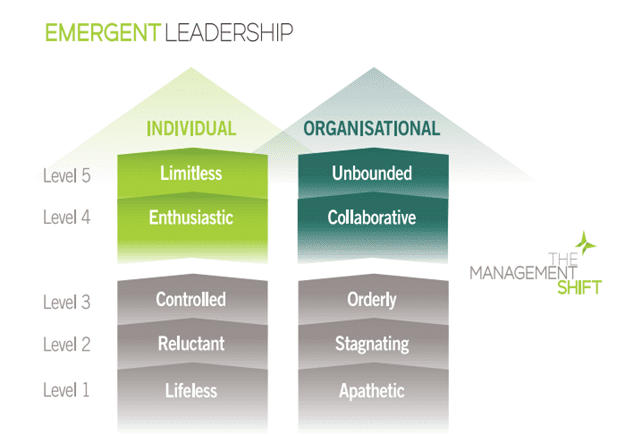-
Provided by

- Date published: Oct 23, 2023
- Categories
Today’s organizations face ever-increasing complexity and change. Leaders need to create a work environment that facilitates purpose, values, and vision to succeed. In this article, we explore how The Management Shift (TMS) approach successfully transitioned Emergn to conscious leadership. Emergn created an effective organizational structure that embraced clarity and purpose by combining powerful insights from both worlds.
The results of The Management Shift program with Emergn have been impressive. Emergn has reported significant improvements within its leadership teams, communication, performance, and organizational culture. Furthermore, following The Management Shift program:
- Average survey participation has increased from 40% to close to 75%
- Emergn moved from the 50th percentile in terms of what ‘good’ looks like across key culture, operational, and belonging topics to the 80th percentile
- Coupled with the launch of a performance management system, Emergn expects a 75% increase in the capture, communication, and ongoing development of key data that directly contributes to improving Emergn as a company and improving its people

Improving leadership performance and company culture with the Management Shift program
One of the key aspects of Emergn’s conscious leadership approach is utilizing The Management Shift program, which helps senior leadership teams develop the skills and knowledge needed to succeed in a fast-paced, ever-changing 21st-century business environment. The program draws on the concept of different levels of management, with each level representing a different stage of organizational development.
The ‘Emergent Leadership’ model as shown in Figure 1 highlights the different levels of conscious leadership.
Figure 1. Emergent Leadership Model (The Management Shift framework)
Emergn has taken various actions to shift its leadership from Level 3 to Level 4, to reach Level 5 in some areas. These steps include:
- Learning the fundamentals through two workshops
- Utilizing e-learning platform assessments and learning material
- Creating a ‘TMS’ channel on Teams for exchanging ideas and experiences
- Establishing a team of TMS champions to take key initiatives forward
- Improving its Performance Management System to include Level 4 language and behaviors that consistently drive and anchor Level 4 culture
- Developing better company surveys that align with TMS thinking and that result in more valuable feedback
Alex Adamopoulos, CEO, Emergn, provides further clarity on some of the most crucial steps the firm has taken, and how these have delivered improvements in culture, communication, and performance.
How Emergn implemented The Management Shift program
The Management Shift approach helped the firm to quantify pushing their leadership to the next level. Adamopoulos emphasizes “the distinction around the different levels.”
The program helped leaders understand the different levels and how to transition from one level to the next. It also taught them how to communicate in a way that is appropriate for each level, using what Alex calls “Level 5 language.”
“Level 5 language is extraordinary in the moment because you are capturing an innovation or an approach that maybe you didn’t think about prior, but now it is on top of mind,” he explains.
Shifting to Level 4
The Management Shift program also emphasizes the importance of organizational values, and how those values align with core tenets of improving and managing performance in an organization to develop talent. Emergn outlines both of these in its guiding principles, known as “The Emergn Way,’ and Emergn’s ‘Incredible Talent Framework.’
By baselining the importance of a Level 4 business and bringing home the values that Emergn aspires to as a company, the program has had a significant impact on the organization.
“One of the things we have applied in our organization is the importance of a Level 4 business, really bringing home the values that we aspire to as a company. That means getting to a place where Level 4 language and thinking happens in a subtle yet intentional manner without needing to call it out” Adamopoulos explains.
They have recently noticed a change in how successes were celebrated within the organization. Alex observed: “One thing I have noticed is that a lot of people are celebrating more in different ways and also supporting their colleagues publicly.
“It is wonderful to see colleagues who genuinely care about and love their co-workers. It feels like we are doing more of that lately as an organization, and that is coming from the Management Shift work we have been doing.”
Meaningful transformation: Creating a long-term leadership shift
Emergn’s success story demonstrates the value of conscious leadership and The Management Shift Model. It has shown that effective leadership begins with vision, values, and purpose and that when done correctly, it can result in meaningful workplace transformation. Organizations seeking a long-term shift in their leadership approach should consider Emergn’s application of The Management Shift approach: one that fosters trust and respect, delivers top talent, and believes in the value of dialogue and collaboration.








